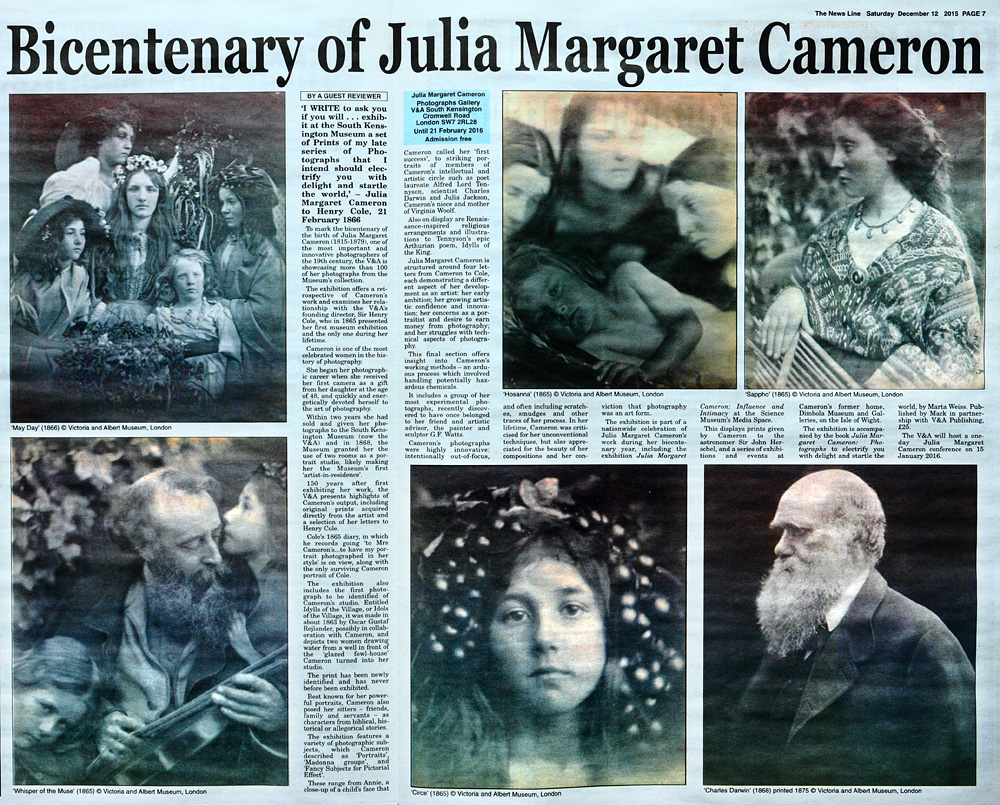 |
|
The News Line Saturday December 12 2015 Pages 6 & 7 Bicentenary of Julia Margaret Cameron Julia Margaret Cameron Photographs Gallery V&A South Kensington SW7 2RL Until
Admission free BY A GUEST REVIEWER 'I WRITE to ask you if you will ... exhibit at the South Kensington Museum a set of prints of my late series of Photographs that I intend should electrify you with delight and startle the world,' - Julia Margaret Cameron to Henry Cole, 21 February 1866 To mark the bicentenary of the birth of Julia Margaret Cameron (1815-1879), one of the most important and innovative photographers of the 19th century, the V&A is showcasing more than 100 of her photographs from the Museum's collection. The exhibition offers a retrospective of Cameron's work and examines her relationship with the V&A's founding director, Sir Henry Cole, who in 1865 presented her first museum exhibition and the only one during her lifetime. Cameron is one of the most celebrated women in the history of photography. She began her photographic career when she received her first camera as a gift from her daughter at the age of 48, and quickly and energetically devoted herself to the art of photography. Within two years she had sold and given her
photographs to the 150 years after first exhibiting her work, the V&A presents highlights of Cameron's output, including original prints acquired directly from the artist and a selection of her letters to Henry Cole. Cole's 1865 diary, in which he records going 'to Mrs Cameron's ... to have my portrait photographed in her style' is on view, along with the only surviving Cameron portrait of Cole. The exhibition also includes the first photograph to be identified of Cameron's studio. Entitled Idylls of the Village, or Idols of the Village, it was made in about 1863 by Oscar Gustaf Rejlander, possibly in collaboration with Cameron, and depicts two women drawing water from a well in front of the 'glazed fowl-house' Cameron turned into her studio. The print has been newly identified and has never before been exhibited. Best known for her powerful portraits Cameron also posed her sitters - friends, family and servants - as characters from biblical, historical or allegorical stories. The exhibition features a variety of photographic subjects which Cameron described as 'Portraits', 'Madonna groups' '. and 'Fancy Subjects for Pictorial Effect'. These range from Annie, a close-up of a child's face that Cameron called her 'first success', to striking portraits of members of Cameron's intellectual and artistic circle such as poet laureate Alfred Lord Tennyson, scientist Charles Darwin and Julia Jackson, Cameron's niece and mother of Virginia Woolf. Also on display are Renaissance-inspired religious arrangements and illustrations to Tennyson's epic Arthurian poem, Idylls of the King. Julia Margaret Cameron is structured around four letters from Cameron to Cole, each demonstrating a different aspect of her development as an artist: her early ambition; her growing artistic confidence and innovation; her concerns as a portraitist and desire to earn money from photography; and her struggles with technical aspects of photography. This final section offers insight into Cameron's working methods - an arduous process which involved handling potentially hazardous chemicals. It includes a group of her most experimental photographs, recently discovered to have once belonged to her friend and artistic advisor, the painter and sculptor G.F. Watts. Cameron's photographs were highly innovative: intentionally out-of-focus, and often including scratches, smudges and other traces of her process. In her lifetime, Cameron was criticised for her unconventional techniques, but also appreciated for the beauty of her compositions and her conviction that photography was an art form. The exhibition is part of a nationwide celebration
of Julia Margaret Cameron's work during her bicentenary year, including
the exhibition Julia Margaret Cameron: Influence and Intimacy at the This displays prints given by Cameron to the
astronomer Sir John Herschel, and a series of exhibitions and events at
Cameron's former home,
The exhibition is accompanied by the book Julia Margaret Cameron: Photographs to electrify you with delight and startle the world, by Marta Weiss, Published by Mack in partnership with V&A Publishing, £25. The V&A will host a one-day Julia Margaret Cameron conference on 15· January 2016. |